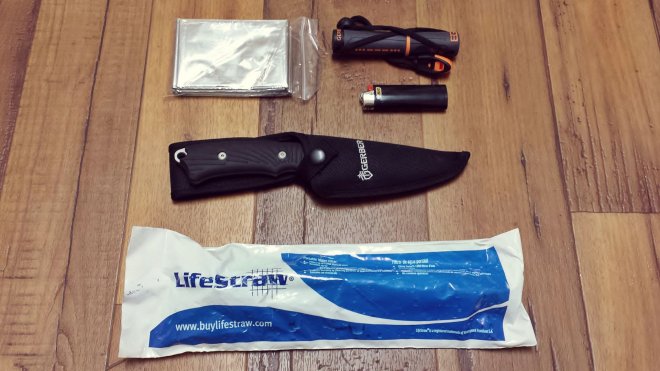Traveling is indeed some of the greatest experiences a human can have on planet earth. The places you’ll go, the things you’ll see, the people you’ll meet are all wondrous possibilities. Anyone that has traveled a lot will tell you about the rich experiences and great memories that last a lifetime.

Essential Survival Gear You Need when Traveling in Nature – Photo Courtesy: Natalie White @ Pixabay
The main things you have to think through are of course trip budget, logistics, and how to stay away from places that are too dangerous. These obstacles are very common and there is tons of advice available on solutions.
The wild world out there is pretty safe, depending on which country you travel in. No matter how sad it may seem, one of the biggest dangers is other people, but if you are smart about it, most trouble can be avoided by being aware, studying the culture’s rules and mindset, and trusting your gut.
It’s been a long time since people at large have feared mother nature. Typically, many places you go are not too far from some form of civilization and therefore a bit of protection against the elements. In fact, modern technology has made most of us forget how dangerous nature can really be. However, it’s rare that someone will find themselves in a life threatening situation in nature, unless they are going far away from civilization, or taking on harsh environments.
With that said, even though it is rare, if you do plan on traveling through nature on your trips, there are a few things that will drastically reduce the danger if you do get caught out in the wild away from the help of technology or civilization.

Essential Survival Gear to Overcome the Dangers of Mother Nature – Photo Courtesy: Tom Sheppard
For that reason, I put together a list of the essential gear that you really should be carrying with you if you do any traveling where you will be out in nature for an extended period of time. I often cover all of the angles of surviving in nature over at Trek Warrior. From what I’ve shared there, these items were selected to guard against the main vulnerabilities that humans have to the outdoors.
As a reminder, the average person can typically survive around 3 hours without shelter in harsh conditions, 3 days without water, and 3 weeks without food. The gear list that follows addresses each of these rules in order of priority, to extend your chances of survival long enough so that you have a much higher chance of getting to safety, or someone rescuing you.
Essential Survival Gear: Shelter
As mentioned earlier, if you get put into some harsh weather conditions, then chances are you may only have three hours before your body gets way too hot or way too cold. In order to address this issue, it is critical that you can create some sort of shelter in order to stay dry and regulate your body temperature.
1. Emergency Blanket (Must Have)

Essential Survival Gear: Emergency Blanket – Photo Courtesy: Tom Sheppard
The smallest and most efficient item that everyone should have on them is an emergency blanket. Typically, these blankets are a thin piece of reflective foil type material. The common use is to wrap yourself with one when you are cold so that most of your body heat that is normally radiated off of you is reflected back into you, keeping you warm.
The other bonus effects are that they are water and wind proof, so they will also keep wind, rain, and snow from making you colder. It is one of the most efficient ways to regulate your body temperature, and you can get them in tightly folded packs that do not take up hardly any space. They come in different colors, including bright orange so that you are easily spotted as well.
If you are stuck in hot climates, you can even use an emergency blanket as a sun block to get out of the sun and into shade. It works best if you fasten the blanket as a sheet that is farther away from you, usually above and at an angle so that you don’t reflect your own body heat right back on to you.
2. Fire Kit (Must Have)

Essential Survival Gear: Fire Kit – Photo Courtesy: Tom Sheppard
While an emergency blanket can help you get out of a jam, you may just need more heat to warm up the body. That’s why it’s important to have the ability to create a fire. If you can carry a lighter on you, that is one of the best ways to go. If not, or if you want a backup, the next best choice is a Ferro rod and striker.
Keep in mind that starting a fire out in nature is not easy at all. Most people think it is until they actually try it the first time. You must have tinder (like dryer lint), kindling (fine thin threads of wood), and bigger wood that is dry. You have to build your fire in stages of getting the tinder burning, then the kindling, and then the bigger wood, otherwise it’s a no go.
3. Knife (Must Have if Possible)
You simply can’t do much in nature without a knife, which is human’s most common tool. You may need to process wood to build a fire, cut the cord for a shelter, process plants for food, or even fight off a threat. Depending on where you are traveling, consider getting a knife that is allowed.
4. Bivy (Nice to Have)
If you want even more protection than an emergency blanket, you can get an advanced version called a bivy. It’s the same type of item, except it is shaped in the form of a sleeping bag that you can crawl inside for better performance.
There are different levels of bivy sacks at very different prices, where you can get more expensive breathable materials that won’t let condensation form inside the bivy. Bivy sacks take up a little more space than an emergency blanket and usually come as a roll the size of a drinking cup.
5. Military Poncho (Optional)
You most likely already have some sort of rain gear as part of your traveling wardrobe. If you have space, a great addition is a traditional military poncho. This item is great because not only can you throw it over your clothes, bag, and gear because it is big enough, but you can also undo it and turn it into a tarp.
If you have paracord on you, you can make this tarp into a makeshift shelter that is easy to sleep inside and get out of the wind and rain. Worst case, you could put the poncho on and sit next to a tree to wait out a rain storm and stay dry.
6. Paracord (Optional)
Cordage has gotten humans through so many struggles in nature in the past. Technology has brought us the ultimate cordage called paracord. It is a super strong rope like an item that can be used to bind all sorts of things together including sticks, tarps, or anything around you in nature to make a shelter.
Essential Survival Gear: Water
Three days may seem like a long time, but it’s not when you are stuck out in nature. If you don’t get water, you will die and before you do, you will be too weak and dehydrated to do much. That’s why it’s important to have a way to drink water that is not full of bacteria and parasites.
7. Filter Straw (Must Have)

Essential Survival Gear: Life Straw – Photo Courtesy: Amazon.com
Modern technology again offers some amazing options that just a decade ago were not available to the masses. Filter straws are small, portable, and allow you to drink from many different types of water sources directly through the straw.
Some great examples include the Life Straw and Survivor Filter. This can be such a life saver that you can’t afford not to have one in your travel pack.
8. Purification Tablets (Optional)
The traditional method of water purification is to use tablets to kill the bad bugs in the water. You can also get tablets that neutralize the taste of the purification tablets so that the water goes down easier. These tablets are small and portable, so it’s a good idea to consider having them. Keep in mind that they do expire though, and you need a water container to put the tablets in for treatment.
Essential Survival Gear: Food
Remember that you go can 3 weeks without food. However, if you try to go that long, you’ll lack energy and you probably won’t be able to move around much.
Food is going to be the biggest challenge because it’s not small if you carry it on you. If you want to be able to trap, catch, or hunt in nature, then you must have a whole slew of equipment to pull that off. It’s usually not a feasible option.
9. Emergency Rations (Optional)
What you can do though is carry extra normal snacks on you, just in case you get stuck in nature. For those that have space in their pack and can handle the extra weight, I always stick with the SOS emergency food ration bars that have 3,600 calories and weigh 1.6 pounds (0.7 kilos). It’s not full course meals, but if you had to, you could ration out those calories to extend out your three weeks.
A smarter solution is to study ahead of time about the environment that you’re in and what the locals feed on in terms of plants. You have to be careful though since a lot of stuff in nature is poisonous and can either incapacitate or kill you.
Putting It Together
We covered the 3 areas of shelter, water, and food in order of priority and the different items that you can carry in your pack to help drastically reduce the danger of getting stuck in nature.
The bare minimum required kit includes: emergency blanket, fire kit, knife, and water filter straw. If you just have these items and know how to use them, then you can potentially make it around 3 weeks in non-harsh environments.
We also covered nice to have and optional items that can help even more if you have space in your pack. With all of the items in mind, the strategy is to address the vulnerabilities of the human body and take control over them to overcome the dangers of mother nature.
